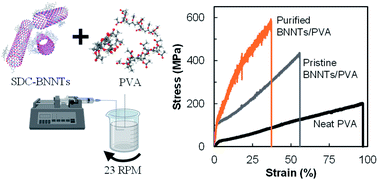Boron nitride nanotubes enhance mechanical properties of fibers from nanotube/polyvinyl alcohol dispersions†
Abstract
Effectively translating the promising properties of boron nitride nanotubes (BNNTs) into macroscopic assemblies has vast potential for applications, such as thermal management materials and protective fabrics against hazardous environment. We spun fibers from aqueous dispersions of BNNTs in polyvinyl alcohol (PVA) solutions by a wet spinning method. Our results demonstrate that BNNTs/PVA fibers exhibit enhanced mechanical properties, which are affected by the nanotube and PVA concentrations, and the coagulation solvent utilized. Compared to the neat PVA fibers, we obtained roughly 4.3-, 12.7-, and 1.5-fold increases in the tensile strength, Young's modulus, and toughness, respectively, for the highest performing BNNTs/PVA fibers produced from dispersions containing as low as 0.1 mass% of nanotube concentration. Among the coagulation solvents tested, we found that solvents with higher polarity such as methanol and ethanol generally produced fibers with improved mechanical properties, where the fiber toughness shows a strong correlation with solvent polarity. These findings provide insights into assembling BNNTs-based fibers with improved mechanical properties for developing unique applications.

- This article is part of the themed collection: Popular Advances


 Please wait while we load your content...
Please wait while we load your content...